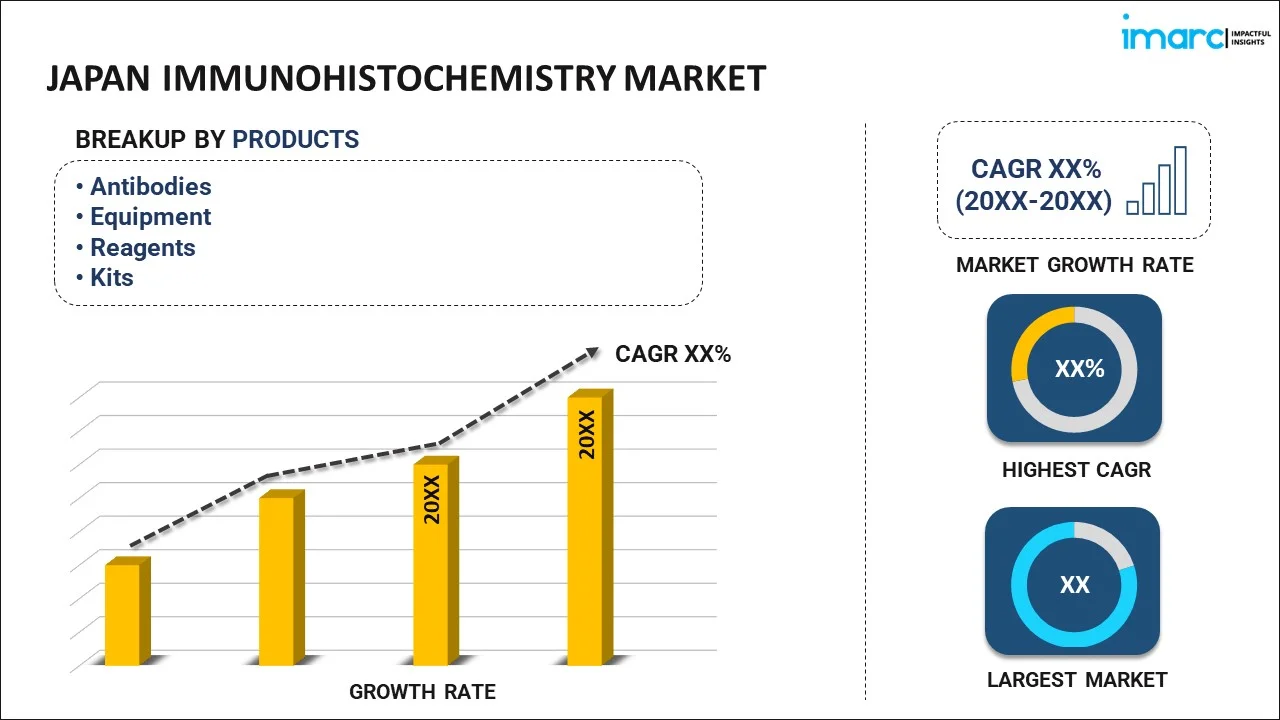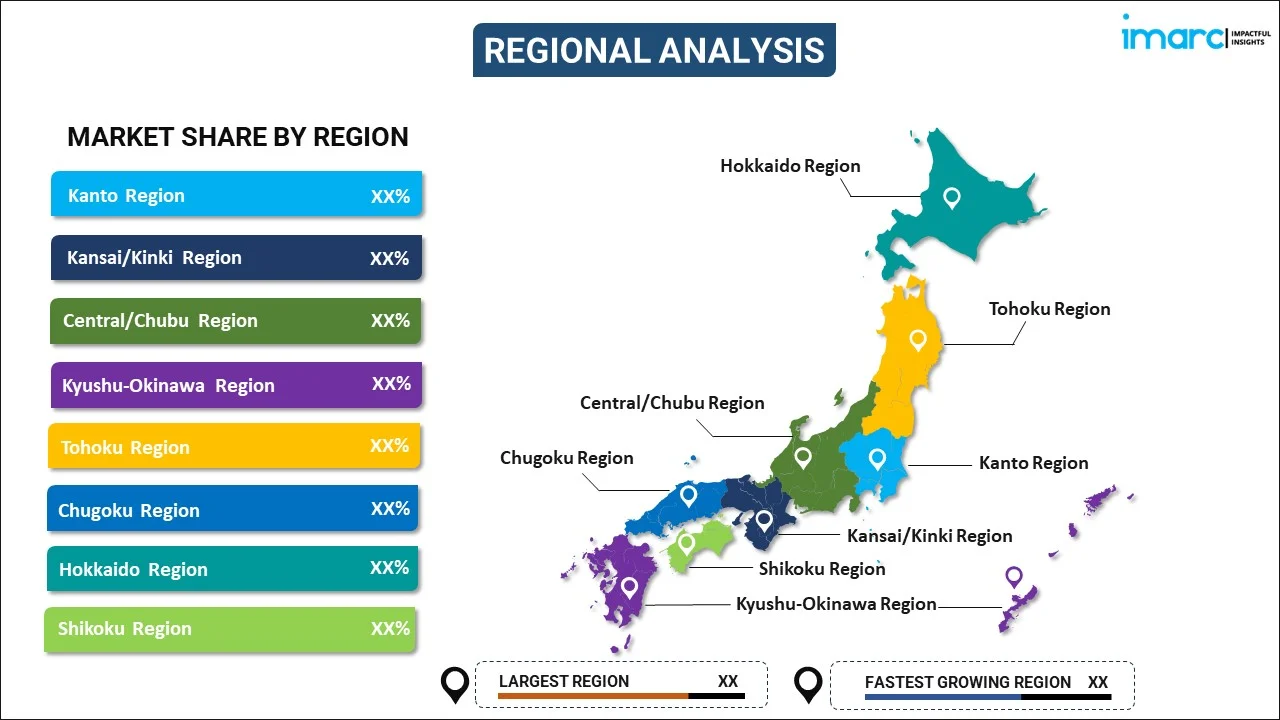
Japan Immunohistochemistry Market Report by Product (Antibodies, Equipment, Reagents, Kits), Application (Diagnostics, Drug Testing), End User (Hospitals and Diagnostic Laboratories, Research Institutes, and Others), and Region 2025-2033
Market Overview:
Japan immunohistochemistry market size reached USD 177.7 Million in 2024. Looking forward, IMARC Group expects the market to reach USD 321.2 Million by 2033, exhibiting a growth rate (CAGR) of 6.1% during 2025-2033. The increasing prevalence of age-related diseases, presence of a strong healthcare infrastructure, growing awareness about personalized medicine, escalating funding and support by the government for medical research, and recent advancements in the field of pathology represent some of the key factors driving the market.
|
Report Attribute
|
Key Statistics
|
|---|---|
|
Base Year
|
2024 |
|
Forecast Years
|
2025-2033 |
|
Historical Years
|
2019-2024
|
| Market Size in 2024 | USD 177.7 Million |
| Market Forecast in 2033 | USD 321.2 Million |
| Market Growth Rate (2025-2033) | 6.1% |
Immunohistochemistry (IHC) refers to a diagnostic and research technique that utilizes the principle of antigen-antibody interactions to identify specific proteins, antigens, or cells within tissue samples. It involves applying antibodies to a slide holding tissue sections, which then react with the antigen of interest and are visualized using chromogenic or fluorescent dyes. Immunohistochemistry is available in several types, including chromogenic, fluorescent, and multiplex. It is comprised of several components, such as primary antibodies, secondary antibodies, detection systems, and substrates. IHC offers multiple features, including high specificity, sensitivity, and the ability to localize cellular components accurately. It is widely used in oncology, neurobiology, infectious diseases, and tissue morphogenesis. Immunohistochemistry also finds application in forensics, environmental studies, and drug testing. It offers cost-effectiveness, speed, and the capability to handle large sample volumes. In addition to this, immunohistochemistry is known for its minimal invasiveness, ability to provide in situ analysis, quantitative capabilities, and seamless integration with automation technology for high-throughput screenings.
Japan Immunohistochemistry Market Trends:
The growing demand for immunohistochemistry, owing to the increasing prevalence of age-related diseases like Alzheimer’s and cancer in Japan, is propelling the market growth. Additionally, the presence of a strong healthcare infrastructure, which supports the adoption of complex diagnostic technologies like IHC, is driving the market growth. Furthermore, the growing awareness about personalized medicine, which is enhancing the demand for targeted diagnostic techniques, is contributing to the market growth. In addition, the escalating funding and support by the government for medical research are catalyzing the market growth. Apart from this, the rising incidences of lifestyle diseases, necessitating early and precise diagnosis, are positively influencing the market growth. Moreover, recent advancements in the field of pathology that are making IHC more crucial, especially for tissue-based diagnoses, are fueling the market growth. Along with this, the rising cooperation between academia and industry, facilitating research and development (R&D) in IHC, is driving the market growth. In line with this, the increasing automation in IHC processes in Japan, which reduces manual errors and enhances throughput, is accelerating the market growth. Furthermore, the broadening application of IHC in drug development and testing, which is opening new avenues for expansion, is acting as another growth-inducing factor. Besides this, rapid improvements in imaging technologies that are enhancing the capabilities of IHC are stimulating the market growth. Additionally, the escalating healthcare expenditure in Japan, which allows for the integration of advanced diagnostic technologies, is providing a boost to the market growth across the country.
Japan Immunohistochemistry Market Segmentation:
IMARC Group provides an analysis of the key trends in each segment of the market, along with forecasts at the country level for 2025-2033. Our report has categorized the market based on product, application, and end user.
Product Insights:

- Antibodies
- Primary Antibodies
- Secondary Antibodies
- Equipment
- Slide Staining Systems
- Tissue Microarrays
- Tissue Processing Systems
- Slide Scanners
- Others
- Reagents
- Histological Stains
- Blocking sera and Reagents
- Chromogenic Substrates
- Fixation Reagents
- Stabilizers
- Organic Solvents
- Proteolytic Enzymes
- Diluents
- Kits
The report has provided a detailed breakup and analysis of the market based on the product. This includes antibodies (primary antibodies and secondary antibodies), equipment (slide staining systems, tissue microarrays, tissue processing systems, slide scanners, and others), reagents (histological stains, blocking sera and reagents, chromogenic substrates, fixation reagents, stabilizers, organic solvents, proteolytic enzymes, and diluents), and kits.
Application Insights:
- Diagnostics
- Cancer
- Infectious Diseases
- Cardiovascular Diseases
- Autoimmune Diseases
- Diabetes Mellitus
- Nephrological Diseases
- Drug Testing
A detailed breakup and analysis of the market based on the application have also been provided in the report. This includes diagnostics (cancer, infectious diseases, cardiovascular diseases, autoimmune diseases, diabetes mellitus, and nephrological diseases) and drug testing.
End User Insights:
- Hospitals and Diagnostic Laboratories
- Research Institutes
- Others
The report has provided a detailed breakup and analysis of the market based on the end user. This includes hospitals and diagnostic laboratories, research institutes, and others.
Regional Insights:

- Kanto Region
- Kansai/Kinki Region
- Central/ Chubu Region
- Kyushu-Okinawa Region
- Tohoku Region
- Chugoku Region
- Hokkaido Region
- Shikoku Region
The report has also provided a comprehensive analysis of all the major regional markets, which include Kanto Region, Kansai/Kinki Region, Central/ Chubu Region, Kyushu-Okinawa Region, Tohoku Region, Chugoku Region, Hokkaido Region, and Shikoku Region.
Competitive Landscape:
The market research report has also provided a comprehensive analysis of the competitive landscape. Competitive analysis such as market structure, key player positioning, top winning strategies, competitive dashboard, and company evaluation quadrant has been covered in the report. Also, detailed profiles of all major companies have been provided.
Japan Immunohistochemistry Market Report Coverage:
| Report Features | Details |
|---|---|
| Base Year of the Analysis | 2024 |
| Historical Period | 2019-2024 |
| Forecast Period | 2025-2033 |
| Units | Million USD |
| Scope of the Report | Exploration of Historical and Forecast Trends, Industry Catalysts and Challenges, Segment-Wise Historical and Predictive Market Assessment:
|
| Products Covered |
|
| Applications Covered |
|
| End Users Covered | Hospitals and Diagnostic Laboratories, Research Institutes, Others |
| Regions Covered | Kanto Region, Kansai/Kinki Region, Central/ Chubu Region, Kyushu-Okinawa Region, Tohoku Region, Chugoku Region, Hokkaido Region, Shikoku Region |
| Customization Scope | 10% Free Customization |
| Post-Sale Analyst Support | 10-12 Weeks |
| Delivery Format | PDF and Excel through Email (We can also provide the editable version of the report in PPT/Word format on special request) |
Key Questions Answered in This Report:
- How has the Japan immunohistochemistry market performed so far and how will it perform in the coming years?
- What has been the impact of COVID-19 on the Japan immunohistochemistry market?
- What is the breakup of the Japan immunohistochemistry market on the basis of product?
- What is the breakup of the Japan immunohistochemistry market on the basis of application?
- What is the breakup of the Japan immunohistochemistry market on the basis of end user?
- What are the various stages in the value chain of the Japan immunohistochemistry market?
- What are the key driving factors and challenges in the Japan immunohistochemistry?
- What is the structure of the Japan immunohistochemistry market and who are the key players?
- What is the degree of competition in the Japan immunohistochemistry market?
Key Benefits for Stakeholders:
- IMARC’s industry report offers a comprehensive quantitative analysis of various market segments, historical and current market trends, market forecasts, and dynamics of the Japan immunohistochemistry market from 2019-2033.
- The research report provides the latest information on the market drivers, challenges, and opportunities in the Japan immunohistochemistry market.
- Porter's five forces analysis assist stakeholders in assessing the impact of new entrants, competitive rivalry, supplier power, buyer power, and the threat of substitution. It helps stakeholders to analyze the level of competition within the Japan immunohistochemistry industry and its attractiveness.
- Competitive landscape allows stakeholders to understand their competitive environment and provides an insight into the current positions of key players in the market.
Need more help?
- Speak to our experienced analysts for insights on the current market scenarios.
- Include additional segments and countries to customize the report as per your requirement.
- Gain an unparalleled competitive advantage in your domain by understanding how to utilize the report and positively impacting your operations and revenue.
- For further assistance, please connect with our analysts.
 Inquire Before Buying
Inquire Before Buying
 Speak to an Analyst
Speak to an Analyst
 Request Brochure
Request Brochure
 Request Customization
Request Customization




.webp)




.webp)












